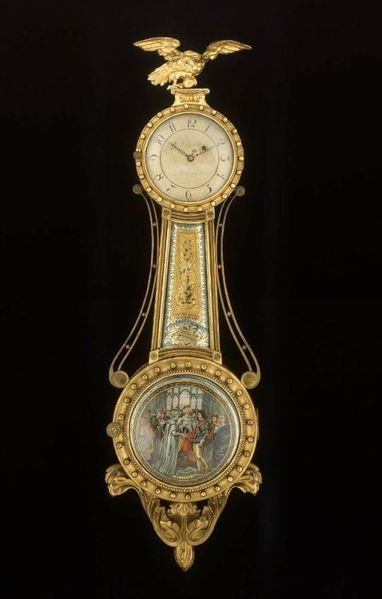Datei:Girandole Wanduhr Lemuel Curtis, 1816–21.jpg

Originaldatei (542 × 850 Pixel, Dateigröße: 43 KB, MIME-Typ: image/jpeg)
Girandole Wanduhr Lemuel Curtis, 1816–21

|
Diese Bild- oder Mediendatei steht unter GNU-Lizenz für freie Dokumentation. Der Urheber gestattet die Vervielfältigung, Verbreitung und Veränderung des Werkes, auch zu kommerziellen Zwecken. Im Gegenzug verpflichtet sich der Lizenznehmer zur Einhaltung der Lizenzbedingungen. Diese sehen unter anderem die Pflicht zur Nennung des Autors oder der Autoren vor und verpflichten den Lizenznehmer dazu, abgeleitete Werke unter die selbe Lizenz zu stellen (Copyleft-Prinzip). Wer sich nicht an die Lizenzbedingungen hält, verliert damit automatisch die durch die Lizenz eingeräumten Rechte. Bei Verwendung in elektronischen Medien genügt als Quellenangabe einer dieser Links: http://watch-wiki.de oder http://watch-wiki.com. |
Images of artworks the Museum believes to be in the public domain are available for download. By downloading this image you agree to the MFA’s Terms of Use.
Every effort has been made to accurately determine the rights status of artworks and/or images on the MFA’s website. Please contact the Intellectual Property Department if you have further information on rights status of an artwork contrary, or in addition to the information in our records.
Girandole wall clock Lemuel Curtis (1790–1857) 1816–21 Concord, Massachusetts, United States. Carved, painted, and gilded wood; brass; reverse glass painting. Dial painted: "L. Curtis / Patent", Glass panel, in script on banner: : "L. Curtis Patent", Oval painted scene labeled: "MARRIAGE."
Dimensions Overall: 116.8 x 34.9 x 14.6 cm (46 x 13 3/4 x 5 3/4 in.)
In 1802, Simon Willard of Roxbury, Massachusetts, was granted a patent for the production of "Willard's Patent Time Pieces," an immensely popular wall clock. Lemuel Curtis, like many clockmakers in New England, had links, both familial and professional, with the seminal Willard shop. After completing his apprenticeship, probably with Simon Willard, Curtis opened his own shop in Concord, Massachusetts, in 1811, where he produced timepieces until he departed for Vermont in 1821. Memoirist Edward Jarvis, in his early reminiscences of Concord, recalled that Curtis's shop was "thirty feet long and ten or twelve feet wide. In a room on the left side he repaired and had a small jewelry store. The rest he used by himself, his men and apprentices as a manufactory of his timepieces."
The Museum's girandole wall clock (named for its use of convex glass in the base section) is a type patented by Curtis in 1816 in his attempt to make a more technologically advanced and aesthetically pleasing model that would surpass the influential Willard version. This example is exceptional for its beautifully rendered image of Marriage depicted in reverse painting on glass (eglomisé), an extraordinarily difficult technique. Curtis asserted in a Boston Intelligencer advertisement from April 12, 1817, "Upon the exteriour [of his clocks] the exertions of genius and taste have not been spared, or any expence," adding that they received "the approbation of the first artists in the United States" and that they were "the best moddeled, and proportioned, and surpassing, in elegance of appearance, any timepiece ever invented." Other subjects depicted on his clocks include Commerce and victorious naval engagements from the War of 1812, fitting themes for "Meeting Houses, Banks, Parlours and other rooms."
This text was adapted from Ward, et al., MFA Highlights: American Decorative Arts & Sculpture (Boston, 2006) available at www.mfashop.com/mfa-publications.html.
Provenance: According to a family tradition, "Count Rumford's first cousin gave this clock to Mrs. Cabot's grandfather in payment of a legal fee." By descent through the Cabot family to Mrs. Charles J. White; by descent to her daughter, Mrs. Charles C. Cabot, Dover, Mass., in 1965; 1977, lent by Mrs. Charles C. Cabot; Gift of Mrs. Charles C. Cabot, Westwood, Mass., 1991 (Accession Date March 27, 1991)
Dateiversionen
Klicke auf einen Zeitpunkt, um diese Version zu laden.
| Version vom | Vorschaubild | Maße | Benutzer | Kommentar | |
|---|---|---|---|---|---|
| aktuell | 17:07, 6. Feb. 2022 |  | 542 × 850 (43 KB) | Andriessen (Diskussion | Beiträge) | Girandole Wanduhr Lemuel Curtis, 1816–21 {{Bildrechte GNU}} Images of artworks the Museum believes to be in the public domain are available for download. By downloading this image you agree to the MFA’s Terms of Use. Every effort has been made t… |
Du kannst diese Datei nicht überschreiben.
Dateiverwendung
Die folgenden 2 Seiten verwenden diese Datei: